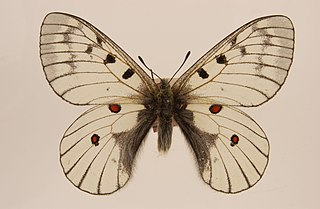
The clouded Apollo is a butterfly species of the family of swallowtail butterflies (Papilionidae) found in the Palearctic realm.

Parnassius delphius, the banded Apollo, is a high-altitude butterfly which is found in Central Asia. It is a member of the genus Parnassius of the swallowtail family, Papilionidae.

Parnassius acdestis is a high-altitude butterfly found in India. It is a member of the genus Parnassius of the swallowtail family, Papilionidae. The species was first described by Grigory Grum-Grshimailo in 1891.

Parnassius glacialis, the glacial Apollo or Japanese clouded Apollo, is a high-altitude butterfly found in Japan, eastern China, and Korea. It is a member of the snow Apollo genus (Parnassius) of the swallowtail family (Papilionidae).

Parnassius clodius is a white butterfly which is found in the United States and Canada. It is a member of the snow Apollo genus (Parnassius) of the swallowtail family (Papilionidae). Its elevation range is 0–7,000 ft (0–2,134 m).

Parnassius ariadne is a high altitude butterfly which is found in Central Asia. It is a member of the snow Apollo genus (Parnassius) of the swallowtail family (Papilionidae).

Parnassius stubbendorfi is a high-altitude butterfly found in from the Altai Mountains across central, south, and far east Siberia, Sakhalin and the Kuril Islands and from Mongolia across north China to west Korea and Japan (Hokkaido). It is a member of the snow Apollo genus (Parnassius) of the swallowtail family (Papilionidae).

Parnassius bremeri is a high altitude butterfly which is found in Russia, Korea and China. It is a member of the snow Apollo genus (Parnassius) of the swallowtail family (Papilionidae). Over its vast range, the species varies widely in morphology and many subspecies have been described.

Parnassius cephalus is a high altitude butterfly which is found in Tibet and west China. It is a member of the snow Apollo genus (Parnassius) of the swallowtail family, Papilionidae. The species was first described by Grigory Grum-Grshimailo in 1891.

Parnassius nordmanni is a high altitude butterfly which is found the Caucasus. It is a member of the snow Apollo genus (Parnassius) of the swallowtail family, Papilionidae. The larva feeds on Corydalis species including C. alpestris, C. conorhiza and C. emanueli.

Parnassius nomion, the Nomion Apollo, is a forest steppe butterfly which is found in the Urals, Altai, south Siberia, Amur and the Ussuri region, Mongolia, China and Korea. It is a member of the snow Apollo genus (Parnassius) of the swallowtail family (Papilionidae).

Parnassius tenedius, the tenedius Apollo, is an east Palearctic member of the snow Apollo genus (Parnassius) of the swallowtail family (Papilionidae). Populations range from Siberia and the Far East of Russia to the western Chukchi Peninsula, Mongolia and north China. The larva feeds on Corydalis species. In the northern part of its range it is a low altitude butterfly; further south it is montane.

Parnassius orleans is a high altitude butterfly which is found in Mongolia, western China and Tibet. It is a member of the snow Apollo genus (Parnassius) of the swallowtail family, Papilionidae. It was named after Prince Henri of Orléans who discovered it.

Parnassius szechenyii is a high-altitude butterfly which is found in western China. It is a member of the snow Apollo genus (Parnassius) of the swallowtail family, Papilionidae. The species was first described by Imre Frivaldszky in 1886.

Parnassius cardinal, the cardinal Apollo, is a high-altitude butterfly which is found in north Afghanistan and Tajikistan. It is a member of the snow Apollo genus (Parnassius) of the swallowtail family (Papilionidae). The species was first described by Grigory Grum-Grshimailo in 1887.

Parnassius felderi, the Felder's Apollo, is a high-altitude butterfly which is found in Amur, Ussuri and China, North Korea and Japan. It is a member of the snow Apollo genus (Parnassius) of the swallowtail family, (Papilionidae).

Chazara briseis, the hermit, is a butterfly species belonging to the family Nymphalidae. It can be found in North Africa, southern Europe, Asia Minor, the Caucasus, Kazakhstan, Central Asia through Afghanistan, and north-western China and Tuva. It is found on steppe and in other dry grassy places between 500 and 2,500 meters.

Melitaea arduinna, or Freyer's fritillary, is a butterfly of the family Nymphalidae. It is found from south-eastern Europe across Asia Minor to central Asia and the Altai. The habitat consists of steppe-clad slopes.

Chazara heydenreichi is a butterfly species belonging to the family Nymphalidae. It can be found from Hindu Kush and the W. Himalaya across Middle Asia and Kazakhstan to the S. Altai.





















